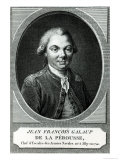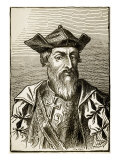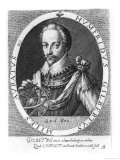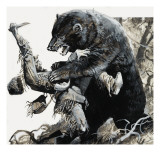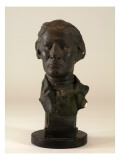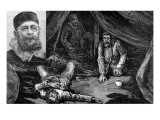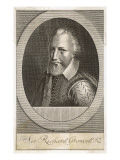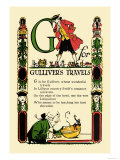|
|
|
|
|
Jean-François de Galaup
b. 8-23-1741; France
d. c 1788; Oceania
Jean-François de Galaup, comte de La Pérouse, a French Navy officer, was asked by King Louis XVI to chart the globe in order to open new maritime routes. The expedition disappeared into the Pacific after La Perouse was able to send his charts and journals on to France saying that he expected to return in December of 1788.
In May of 2005 a wreck off the Solomon Islands was confirmed as La Boussole, one of two expedition ships; fellow Frenchman Dumont d'Urville located the general area of the sinkings on one of his explorations.
La Perouse's voyage was notable for the number of scientists on board, that La Pérouse observed the only historical eruption of Mount Shasta on September 7, 1786, and that a sixteen year old Paris military academy student by the name of Napoleon Bonaparte did not make the final list for the crew.
• Pacific Explorer: The Life of Jean-Francois de La Perouse
|
|
|
|
Vasco da Gama
b. c. 1469; Sines or Vidigueira, Alentejo, Kingdom of Portugal
d. 12-23-1524: Cochin, India (malaria)
Portuguese navigator Vasco da Gama led the expedition that opened the first European sea route to India. On his voyages, he explored the coasts of Africa and India. He helped Portugal extablish colonies in India and the Spice Islands, near present-day Indonesia. Da Gama paved the way, partly by force, for Portugal to become the leading trader in the products of the Orient and one of the greatest sea powers of the 16th century.
In the 15th century, Arab Muslims controlled all the known overland and sea routes to Asia, and these routes were closed to Europeans. The Portuguese king, Manuel I, was determined to find a water route that would give his country access to the spices of the East. King Manuel selected Vasco da Gama, a gentleman of the royal court, to command Portugal's first expedition to India. Da Gama sailed south and then east, rounding the Cape of Good Hope at the southern tip of Africa. It took ten months for his fleet to sail from Lisbon, Portugal, to Calicut, India, and another year to sail home. The voyages were marked by long periods of calm followed by violent storms. Food ran low, and the men became ill. Several times when the ships stopped for food or water they were attacked by African natives or by Muslims. On this expedition, almost two-thirds of da Gama's 170 men died. Even after he finally reached Calicut, da Gama was unable to conclude a trade agreement because of the poor quality of the trade goods he carried. Da Gama did manage to take some spices and other goods back to Portugal. Although a later Portuguese expedition succeeded in getting a trade agreement with the Indians, the Portuguese still faced violent opposition from the Arab traders.
On his second voyage to India, da Gama had order to punish the Africans and Indians who had been hostile to the Portuguese, destroy Arab shipping, and get control of the spice trade. He attacked along the coasts of eastern Africa and western India, forcing some of the settlements there to form alliances with Portugal. He returned to Lisbon with a rich cargo acquired through trade and by plundering Muslim ships. Da Gama helped the Portuguese take control of the spice trade. But within a few years, the Portuguese in India became corrupt and weak. Da Gama sailed to India again, this time to discipline the Portuguese. He served as a representative of the Portuguese king for only a short time before he fell ill and died. (based on text from an out of print poster series)
FYI - the longest bridge in Europe (over the Tagus near Lisbon) is named for Vasco de Gama.
See Luís de Camões epic poem Os Lusíadas
|
|
|
|
Sir Humphrey Gilbert
b. c. 1537; England
d. 9-9-1583; at sea
Sir Humphrey Gilbert, adventurer and explorer, was a half brother of Sir Walter Raleigh. He is considered to have claimed the first English property in North America.
|
|
|
|
Christopher Gist
b. 1706; Baltimore, MD
d. 1759; Virginia, South Carolina or Georgia (possibly smallpox)
Christopher Gist, one of the first white explorers of the Ohio Country, was credited with providing the first detailed description of the Ohio Country to Great Britain and her colonists. Gist also accompanied George Washington on missions in the Ohio Country.
|
|
|
|
Hugh Glass
b. c. 1780; Pennsylvania
d. 1833; along the Yellowstone River, Ariara attack
Explorer and hunter Hugh Glass is best remembered for his legendary cross-country trek after being mauled by a grizzly bear.
Glass was active in the watershed of the Upper Missouri River in present day North Dakota, South Dakota and Montana.
• Hugh Glass at Amazon
|
|
|
|
Robert Gray
b. 5-10-1755; Tiverton, RI
d. July 1806; Charleston, SC (possibly yellow fever)
Merchant sea captain Robert Gray was the first American to circumnavigate the globe, the result of sailing from Boston, around Cape Horn to the west coast of North America - northern California, Oregon, Washington, British Columbia to trade for fur pelts, saliing to Canton, China, trading for tea and returning to Boston across the Indian Ocean, the Cape of Good Hope, and Atlantic Ocean.
Gray also discovered, and named, the Columbia River after his ship, the Columbia Rediviva.
Gray is said to have served in the Continental Navy, a veteran of the Revolutionary War (undocumented).
|
|
|
|
Adolphus Greely
b. 3-27-1844; Newburyport, Massachusetts
d. 10-20-1935; Washington, DC
Adolphus Greely explored the Arctic polar region (1881) to establish a chain of meteorological-observation stations for observing astronomical and magnetic data. He was also looking for the USS Jeannette, lost 1879. The Greely group was also nearly lost, forced to winter at Cape Sabine with inadequate rations and little fuel.
FYI ~ Fort Greely was established in Alaska (1955), to honor Greely.
|
|
|
|
Sir Richard Grenville
b. 6-15-1542; Bideford, Devon, England
d. 9-10-1591; off Flores, Azores Islands
Sea captain Sir Richard Grenville proposed the plunder of Spanish treasure ships and to search for a shorter Spice Islands route, a plan eventually carried out by Sir Francis Drake.
Grenville participated in early attempts (1585) to colonize the New World with settlers at Roanoke Island, and later prepared defenses (1588) for a battle with the Spanish Armada.
Grenville died of wounds sustained in a battle with the Spanish - see Alfred, Lord Tennyson The Revenge: A Ballad of the Fleet.
|
|
|
|
Lemuel Gulliver
Lemuel Gulliver is the title character in Jonathan Swift's novel Travels into Several Remote Nations of the World. In Four Parts. By Lemuel Gulliver, First a Surgeon, and then a Captain of Several Ships (1726). Published seven years after Daniel Defoe's story of shipwrecked Robinson Crusoe (1719), Gulliver's Travels parodied European politics and religion.
• alphabet posters
|
|
|
previous page | top | next
exploring > Great Explorers List | a | b | c | d | e | f
| G | h | i-j-k | l | m | n-o | p | q-r | s | t-u | v | w-x-y-z
|
|
I have searched the web for visual, text, and manipulative curriculum support materials - teaching posters, art prints, maps, charts, calendars, books and educational toys featuring famous people, places and events - to help teachers optimize their valuable time and budget.
Browsing the subject areas at NetPosterWorks.com is a learning experience where educators can plan context rich environments while comparing prices, special discounts, framing options and shipping from educational resources.
Thank you for starting your search for inspirational, motivational, and educational posters and learning materials at NetPosterWorks.com. If you need help please contact us.
|
|
|












